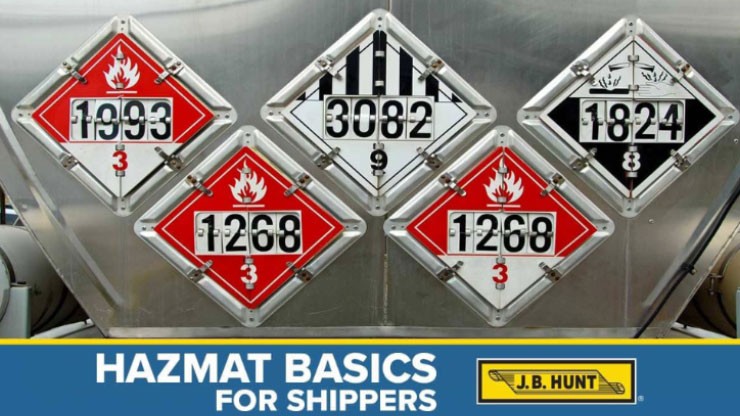Hazmat Compliance Basics for Shippers

The world of hazmat compliance is vast and complicated. There are many responsibilities placed on manufacturers, shippers and carriers – with some overlapping to ensure quality control. Hazmat safety is incredibly important; when a hazardous material is not packaged, marked and transported properly, everybody is at risk. The Department of Transportation (DOT), Federal Motor Carrier Safety Administration (FMCSA), and Pipeline and Hazardous Materials Safety Administration (PHMSA) have gone to great lengths to compile regulations and requirements in an understandable way. Use the information below as a starter guide to determining a shippers’ responsibilities in transporting hazardous materials. For further education and clarification, visit the FMCSA’s compliance guide.
Defining Hazardous Materials
The DOT defines hazardous materials as those designated by the DOT’s Secretary as posing an unreasonable threat to the public and environment. Items qualified as “hazardous materials” include hazardous substances; hazardous wastes; marine pollutants; elevated-temperature material; and materials identified in 172.101 of Title 49 Code of Federal Regulations (49 CFR). Federal regulations apply to all interstate and intrastate shipments of HMs by highway, with exceptions for materials of trade, agriculture operations and certain non-specification packaging used in commerce.
Training and Registration
The following training requirements apply to any employer or contractor of the shipper who handles or comes into contact with hazmat-classified goods:
- General awareness/familiarization of hazmat requirements and regulations
- Function-specific training in which it applies to the handling or contact of hazardous materials
- Safety training concerning hazards posed by materials in the workplace and personal protection measures; training may include basic emergency response procedures but is not required
- Security training that includes awareness of security risks associated with HM transportation and methods designed to enhance transportation security (must be completed within 90 days of becoming a new hazmat employee)
- Modal-specific training as required by 49 CFR Parts 174, 175, 176 or 177
- Continued training must be followed at three-year intervals by all hazmat employees
In addition to security training, shippers that are required to have a security plan in place must properly train all HM employees and contractors in that security plan and its implementation. Records showing current training, including the preceding three years, must be available to the DOT upon request.
Shipping Hazardous Materials
Shippers are responsible for the following when shipping a hazardous material:
- Shipping paper
- Any necessary certifications
- Proper packaging and labeling
- Blocking and bracing
- Provide placards for each side of container
- Security plan
- Incident reporting
Packing Groups and Packaging
Packing groups indicate the degree of danger presented by the material. Shippers are responsible for determining the packing group and its packaging requirements. Packing groups are:
- I (Great)
- II (Medium)
- III (Minor)
Based on written instructions by the manufacturer, the shipper will perform all actions necessary for the packages to conform to federal requirements. Proper packaging methods must consider filling limits, compatibility between the hazardous material and its container, and securing and cushioning of dangerous goods.
Emergency Response Information
All companies that ship hazmat items must provide an emergency response telephone number that is monitored at all times while the shipment is in transit. Specific information must be conveyed to the carrier on the shipping paper or a separate document attached to the shipping paper. Necessary information includes:
- Description of the hazardous material
- Immediate hazards to health
- Immediate methods for handling small or large fires, spills, or leaks
- Preliminary first aid measures
If a carrier’s equipment features an emergency response guide or similar document onboard, a separate emergency response document is not required.
Marking and Labeling
Packages containing hazardous items must be clearly marked with the proper shipping name and identification number of the packaged materials. Visit the FMCSA’s guide for exceptions. Markings should be:
- Durable
- Written in English
- Clearly visible
When required, technical names must be marked in parenthesis alongside the proper shipping name. A carrier should not agree to transport a hazardous material without compliant package labeling.
Placards
The shipper is responsible for providing the carrier with required placards for placement on the vehicle and packages. If the carrier’s vehicle is already affixed with the proper placards, there is no need to provide additional placards. Placards must not be damaged in any way. No motor carrier may transport a hazardous material in a motor vehicle unless the necessary placards are affixed as required. It is recommended that all drivers carry an extra placard.
Compatibility
Shippers and carriers are responsible for compatibility. Such requirements can be referenced in the Segregation Table for Hazardous Materials and Compatibility Table for Class 1 (Explosive) Materials. Shippers must comply with compatibility considerations before sending the items for shipment. ------ As is common with such complex regulatory procedures, there are many exceptions to these requirements. Your freight solutions provider should be able to provide assistance and guidance as to how best to ship hazardous items, as well as which requirements the shipper may be responsible for. As always, safety is the key component of shipping hazardous materials. Don’t let responsibility slide or cut corners; the effects of a non-compliant hazardous shipment can be devastating.

